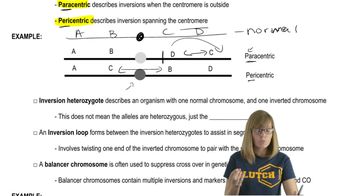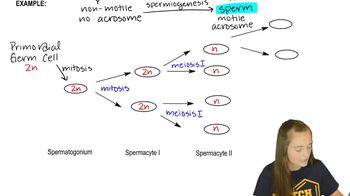Table of contents
- 1. Introduction to Genetics51m
- 2. Mendel's Laws of Inheritance3h 37m
- 3. Extensions to Mendelian Inheritance2h 41m
- 4. Genetic Mapping and Linkage2h 28m
- 5. Genetics of Bacteria and Viruses1h 21m
- 6. Chromosomal Variation1h 48m
- 7. DNA and Chromosome Structure56m
- 8. DNA Replication1h 10m
- 9. Mitosis and Meiosis1h 34m
- 10. Transcription1h 0m
- 11. Translation58m
- 12. Gene Regulation in Prokaryotes1h 19m
- 13. Gene Regulation in Eukaryotes44m
- 14. Genetic Control of Development44m
- 15. Genomes and Genomics1h 50m
- 16. Transposable Elements47m
- 17. Mutation, Repair, and Recombination1h 6m
- 18. Molecular Genetic Tools19m
- 19. Cancer Genetics29m
- 20. Quantitative Genetics1h 26m
- 21. Population Genetics50m
- 22. Evolutionary Genetics29m
6. Chromosomal Variation
Chromosomal Rearrangements: Inversions
Problem 15b
Textbook Question
A normal chromosome and its homolog carrying a paracentric inversion are shown here. The dot (·) represents the centromere.
Normal ABC • DEFGHIJK
Inversion abc • djihgfe
Assume a crossover takes place in the region between F and G. Identify the gametes that are formed following this crossover, and indicate which if any gametes are viable.
 Verified step by step guidance
Verified step by step guidance1
<span>1. Understand the structure of the chromosomes: The normal chromosome is ABC • DEFGHIJK, and the inverted chromosome is abc • djihgfe. Note that the inversion is paracentric, meaning it does not include the centromere.</span>
<span>2. Identify the crossover region: The crossover occurs between F and G. In the normal chromosome, this region is between F and G, while in the inverted chromosome, it is between f and g.</span>
<span>3. Determine the crossover products: During crossover, segments of the chromosomes are exchanged. This will result in two recombinant chromatids and two non-recombinant chromatids.</span>
<span>4. Analyze the structure of the recombinant chromatids: Due to the paracentric inversion, one of the recombinant chromatids will form a dicentric bridge (two centromeres), and the other will form an acentric fragment (no centromere).</span>
<span>5. Evaluate the viability of the gametes: The dicentric bridge is typically unstable and will break during cell division, and the acentric fragment will be lost. Therefore, only the non-recombinant chromatids are likely to form viable gametes.</span>
Recommended similar problem, with video answer:
 Verified Solution
Verified SolutionThis video solution was recommended by our tutors as helpful for the problem above
Video duration:
4mPlay a video:
Was this helpful?
Key Concepts
Here are the essential concepts you must grasp in order to answer the question correctly.
Chromosomal Inversion
A chromosomal inversion occurs when a segment of a chromosome is reversed end to end. In the case of a paracentric inversion, the inverted segment does not include the centromere. This structural alteration can affect gene expression and recombination during meiosis, particularly when crossovers occur within the inverted region, leading to potential formation of non-viable gametes.
Recommended video:
Guided course

Inversions
Crossover and Recombination
Crossover is a genetic process that occurs during meiosis where homologous chromosomes exchange segments of genetic material. This recombination can create new allele combinations in gametes. The location of the crossover is crucial; in this scenario, a crossover between genes F and G in the presence of a paracentric inversion can lead to the production of gametes with duplications or deletions of genetic material, affecting their viability.
Recommended video:
Guided course

Recombination after Single Strand Breaks
Viability of Gametes
The viability of gametes refers to their ability to develop into a functional organism after fertilization. In the context of chromosomal abnormalities, such as those resulting from crossovers in inverted chromosomes, some gametes may carry lethal combinations of genes or imbalances in chromosome structure, rendering them non-viable. Identifying which gametes are viable requires analyzing the genetic content produced by the crossover.
Recommended video:
Guided course

Gamete Development
Related Videos
Related Practice



